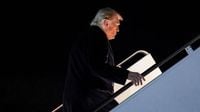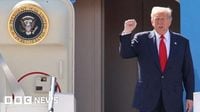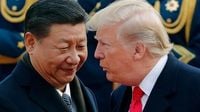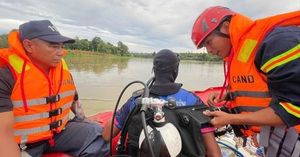US President Donald Trump landed in Kuala Lumpur, Malaysia, on October 26, 2025, launching a high-stakes diplomatic tour of Asia that has already drawn global attention. The trip, his first to the Asia Pacific since his re-election, comes at a moment when the world’s two largest economies are locked in a tense trade war, and the US government itself is mired in a shutdown. Yet, if Trump felt the weight of these challenges, he didn’t show it as he stepped off Air Force One, ready to put his dealmaking skills to the test on a continent hungry for stability and economic opportunity.
Trump’s first order of business was the annual summit of the Association of Southeast Asian Nations (ASEAN), hosted in Kuala Lumpur. According to AP, the president’s agenda was packed: he aimed to solidify a trade agreement with Malaysia, oversee the signing of an expanded ceasefire between Cambodia and Thailand, and lay the groundwork for a much-anticipated meeting with Chinese leader Xi Jinping. The stakes couldn’t be higher—not just for Trump’s legacy, but for the global economy and the fragile peace in Southeast Asia.
“I think we have a really good chance of making a very comprehensive deal,” Trump told reporters traveling with him on Air Force One, as reported by BBC. He expressed hope that his face-to-face with Xi could yield progress on a range of issues, from fentanyl trafficking to the resumption of Chinese purchases of American soybeans—an issue close to the hearts of US farmers. “I want our farmers to be taken care of. And he wants things also,” Trump added, hinting at the delicate balancing act ahead.
The ASEAN summit itself was set against a backdrop of regional tension and opportunity. Tariffs and access to rare earth minerals—critical for everything from semiconductors to smartphones—dominated the agenda, as did the ongoing US-China trade war. According to Al Jazeera, Southeast Asian nations were keenly aware of their position between two economic giants, with their export-driven economies battered by the tariff standoff and their manufacturing sectors deeply intertwined with both US and Chinese supply chains.
Yet, Trump’s presence at the summit was about more than just trade numbers. As BBC correspondent Jonathan Head put it, the US president appeared determined to play “the starring role in a ceremony arranged specially for him,” where Thailand and Cambodia would sign a peace accord after months of sporadic violence along their disputed border. The conflict, which erupted into five days of combat in July and left dozens dead and hundreds of thousands displaced, had threatened to destabilize the region. Trump’s threat to withhold trade agreements unless fighting stopped, a move described by Phnom Penh’s Future Forum think tank as “very, very significant,” is credited with forcing the two sides to the negotiating table.
“That’s probably the main reason, if not the only reason, but definitely the main reason why the two sides agreed immediately to the ceasefire,” said Ou Virak, the think tank’s president, as quoted by AP. Now, with the signing of a joint declaration in Kuala Lumpur, Thailand and Cambodia have committed to renewing their relations and addressing concerns about landmines and heavy artillery along the border. “It’s not an end in itself,” Thai foreign ministry spokesperson Nikorndej Balankura cautioned, “Work has just begun.”
Malaysia’s role in brokering the ceasefire did not go unnoticed. Trump praised Prime Minister Anwar Ibrahim for helping to resolve the conflict, saying, “I told the leader of Malaysia, who is a very good man, I think I owe you a trip.” The United States and Malaysia were also expected to finalize a trade agreement during Trump’s visit, a move that could provide a much-needed boost to both economies.
But the trip was not without its complications. As Trump’s motorcade wound through Kuala Lumpur, the US government shutdown continued to grind on back home, with federal workers missing paychecks and air traffic controllers working without pay. “America is shut down and the President is skipping town,” said Senate Democratic leader Chuck Schumer, according to AP. Still, Trump pressed ahead, betting that progress overseas could yield dividends at home.
After Malaysia, Trump’s itinerary included stops in Japan and South Korea—two key US allies and major trading partners. In Japan, he was set to meet with newly elected Prime Minister Sanae Takaichi, the country’s first female leader and a protégé of the late Shinzo Abe, who was assassinated after leaving office. According to BBC, Takaichi’s government had agreed to invest $550 billion in US supply chains for pharmaceuticals and semiconductors, in exchange for a reduction in US tariffs on Japanese cars from 27.5% to 15%. The deal, if finalized, would be a boon for Japan’s auto giants and a sign of continuity in the US-Japan relationship.
In South Korea, Trump was expected to push for a similar deal to lower US duties on Korean exports, though talks had stalled over his demand for a $350 billion upfront investment—an amount Seoul fears could destabilize its economy. Korean officials, however, expressed cautious optimism that “tangible progress” could be achieved by the end of the summit.
The centerpiece of Trump’s Asia trip, though, was always going to be his meeting with Xi Jinping. Scheduled for October 30 in Busan, South Korea, on the sidelines of the Asia Pacific Economic Cooperation (APEC) summit, the encounter was billed as the first face-to-face between the two leaders since 2019. As BBC’s Anthony Zurcher noted, the outcome could set the course for US-China relations—and, by extension, the global economy—for years to come.
Xi, for his part, was playing a long game. Leveraging China’s near-monopoly on rare earth minerals and its ability to inflict pain on US farmers by halting soybean purchases, he was prepared to endure tariffs and domestic hardship in pursuit of strategic advantage. Analysts believed China might offer concessions if Trump agreed to export advanced AI chips or ease military support for Taiwan, but the path to a deal remained fraught.
Meanwhile, Trump signaled that he might raise the case of Jimmy Lai, the jailed pro-democracy newspaper founder, with Xi—a move sure to test the limits of their diplomatic rapport. “It’ll be on my list,” Trump remarked to reporters, as reported by AP.
As the week unfolded, the world watched for signs of progress—or peril. For Southeast Asia’s export-driven economies, any easing of US-China tensions would bring relief, while manufacturers in Vietnam, Indonesia, Singapore, and Thailand braced for the impact of tariffs that could range from 10% to 40%. Even US chipmakers like Micron Technology, which operates major plants in Malaysia, had reason to hope for “ink on paper,” as BBC’s Suranjana Tewari put it, and not just more promises.
Trump’s Asia tour, then, was more than a diplomatic roadshow. It was a test of whether personal diplomacy, economic leverage, and the lure of peace could deliver tangible results in a world where uncertainty is the only constant. As leaders posed for photographs and signed agreements in Kuala Lumpur, the real work—building trust, resolving conflicts, and rebalancing the global economy—was just beginning.






